Text
Final Year Research Project: Campsie Fells’ Edit
The edit for Campsie Fells lasted about two weeks. Luca transcoded and synchronized as I was out of town the weekend after the film got shot, and then he made a rough sequence of the performances he thought were the best. When I started editing at the beginning of the week I didn’t even look at his edit. I just didn’t want to get influenced by it. So I started doing a sequence only with close-ups. The day after I did a sequence only with the wides. Only after having tried that I dared mixing the two shots in a sequence. Luca and me did one last sequence together: I was editing and he was ‘supervisioning’ me, we were making compromises on which shots to put, the cuts, the pace etc. It worked out pretty well. But we still had a problem: continuity issues. We decided to ignore them and prioritize the performances. My objective was exactly to give space to the actors since the very beginning, when I understood Luca’s script was based a lot on performances, how the actors deliver certain lines and impersonate the characters. After all, how Walter Murch says in his book ‘In the Blink of an Eye’, emotion always comes first. Citing from his book: ‘How do you want the audience to feel? If they are feeling what you want them to feel all the way through the film, you’ve done about as much as you can ever do. What they finally remember is not the editing, not the camerawork, not the performances, not even the story – it’s how they felt’.
0 notes
Text
Final Year Research Project: Filming the Zero Waste Hub
Today we went to the Zero Waste Hub. Again, we have been unlucky with the weather because it was very rainy. However, we filmed most of the things inside the shop so the equipment was safe. We only had one shot in which we entered the shop, that was outside.
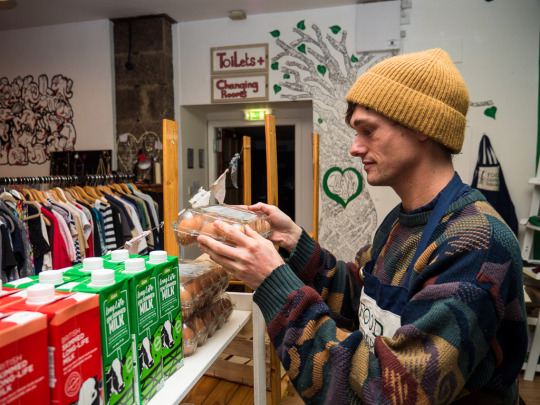
We met Sydney, who is one of the paid volunteers at the shop. He’s a lovely person, very kind and available to us for whatever we needed. We filmed details of the shop such as bread, vegetables, fruit they had and then we filmed Sydney selling the products. We also had wider shots of the whole space. This time we used my camera so it was a bit easier for us to understand how it worked (it’s also more lightweight, even if it’s not a professional camera it did the job). We preferred not interviewing Sydney since we already had Ciara’s voiceover explaining what the Zero Waste Hub was.
0 notes
Text
Final Year Research Project: New Ideas
Today, Via and me sat down to think about the stylistic approach and we got new ideas. She thought we could follow the life of a vegetable from the farm to it being thrown in the bins. It could potentially be a bell pepper, a zucchini or a potato. We chose the bell pepper for now just because we like it, but it might be subject to change. She said we could have POV shots of the vegetable.
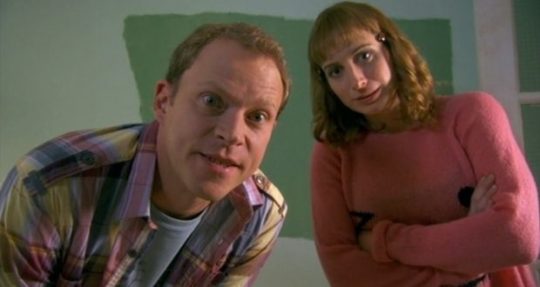
I really liked the idea, but I suggested that we could show the process in reverse: instead of going from the farm to the bins, we could go from the bins to the farm. This way, we would be able to show that the problem is not at the ‘throwing away’ stage, but at the production stage, as Ciara said. However, this would change a lot of things. The test shoot that we made is no longer representative to what we are going for. We must make it clear during the presentation. However, we already have half of the characters (Dan and Sydney) and we only have left to contact a supermarket and a farm, which we will do as soon as possible next semester when (if) the project gets approved. Indeed, we scheduled a whole month to finish producing in January and we will only film in February or better mid-February, hoping that the weather is good.
0 notes
Text
Final Year Research Project: Filming Ciara and skipping
Last week, on Wednesday, we invited Ciara for dinner and she agreed to be filmed, which we were very happy about. We were afraid we wouldn’t have her important opinions to include at least in the test shoot - but we now we do! The filming was pretty challenging. We took an URSA mini but both Via and me had not filmed anything since first year, so we had to figure out everything by ourselves. We’re pretty bad cinematographers though, and we realized only later that the picture was too dark. We also forgot to get a tripod, so we had to find a way to put the camera on the table. It worked ok, but we were terrified of doing any mistake. Some days later we also filmed Dan skipping. That was also a challenging shoot because it was dark and rainy. We filmed him walking to the bins, we had a short interview on the way, and then him looking for food through the bins and coming back with what he rescued.
0 notes
Text
Final Year Research Project: Tutorial + meeting Lily Sandelin
Yesterday we met Paul Gray for our tutorial. Even though we have a clearer idea in mind about what our documentary is going to be on, we still don’t have many ideas for the style and mode of address we want to take on. Paul asked about documentary filmmakers that inspire us and I replied saying I like Adam Curtis, who uses a lot of archive and stock footage, which is not something Via and me want to do. We talked about possibilities to use time-lapse (we looked at many time-lapses of food rotting) and stop motion. Via and me said we would like to use stop motion as interlude between one part of the film and another, at the opening of certain subparts or chapters of the film. Yesterday we also met Lily Sandelin, a lecturer at ECA who Via interviewed last year for a module. She’s a producer so she knows many filmmakers in Edinburgh. She suggested to us places where to look for a cinematographers, sound recordists and sound designers. She previously gave us a list of names we could check. She also gave us ideas about the documentary and which perspective it could take. She invited her husband and he talked to us about sound, how it is important to have good sound in a film. In his opinion, a film can have bad images but not bad sound. He gave us a lot of advices on how to record sound. Lily also suggested to send the documentary to BBC shorts, a series of short documentaries, but we will see how the result will be first. We would really like to make a worthy documentary that we can send to festivals.
0 notes
Text
Final Year Research Project: The Pitch
The pitch went pretty ok. Via couldn’t come because she was ill, but I think I managed well even on my own. Paul said the slides were clear and he didn’t have much to add. He saw that we chose to go towards a specific direction, which we didn’t have when we met for the tutorial. Indeed, at the tutorial we still had not met Ciara and therefore we didn’t have her perspective on the Zero Waste Hub. But by the time I pitched, we had more of a clear idea of what to film and how to approach it. Zoe didn’t have much feedback either, she said the idea is a very ‘Irene’ thing to do but that I should stick to one idea instead of changing my mind constantly, the way I ususally do in her opinion. Klau had a good question: how do we link the skipping part to the Zero Waste Hub? We still don’t know very well, but we think that probably we will have a character linking the two things (doing both the skipping and going into the Zero Waste Hub). However, Ciara said she doesn’t want to be filmed for the final project which worries us - we still have to find a way to convince her. I already asked Klau and Fiann to be our cinematographers but they said no. So we are still looking for cinematograopher, sound recordist and sound designer. We will probably have to film the test shoot by ourselves.
0 notes
Text
Final Year Research Project: Ciara

Today we met Ciara, a friend of mine. She’s the one on the left in the picture I’m posting. She’s been a volunteer at the Food sharing Hub (also called Zero Waste Hub) since it opened. She had a lot to tell us. She thinks the Zero Waste Hub is a great idea but it doesn’t help that much, because the amount of energy produced is still the same, even if people find a way to not waste all the food. Also, she told us that supermarkets and groceries have to pay a fine to get rid of the surplus of food, so the Zero Waste Hub, by not letting them pay the fine, would encourage food waste rather than solving the issue. Ciara also told us (as we already guessed) that the majority of customers are students and that in her opinion the food that is being ‘rescued’ could be used instead to feed those who are more in need (for example, it could go to a food bank). She thinks, though, that the shop is a great community of people who try to change things, everyone having their best intentions. However, her criticism has been very interesting to us and we’re thinking of using it as a base for our documentary. We’re thinking of showing the ‘positive’ side and the ‘negative’ side of the matter.
0 notes
Text
Final Year Research Project: Food waste!
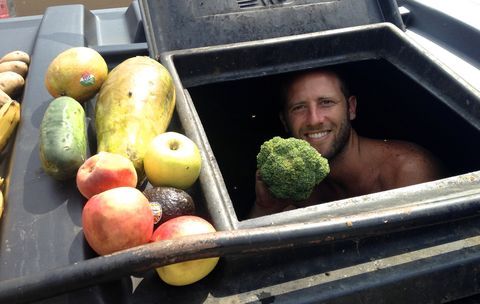
After a talk, Via and me decided to make a documentary on food waste. We have many things in mind, skipping first of all. It’s a trend in Edinburgh especially among students. It means going to the back of supermarkets to get free food from the bins. Also, there are two organizations in Edinburgh that are highly interesting to us: the Foodsharing Hub and the Real Junk Food Project. We have to look at them more in depth in the next meeting. Meanwhile, we are starting to do the slides for the pitch which will be the 17th of October (next week). We still have to find our main character/s. However, we are sure we are going to find someone in our group of acquaintances. Even if it isn’t someone we know, we might find someone who is known by someone we know. There’s a lot of people who like skipping and who are involved with the Foodsharing Hub in the place where we live.
0 notes
Photo
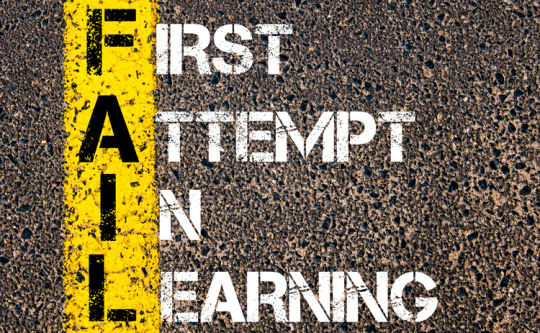
Final Year Project Research: we changed our minds.
Even if we thought we found the perfect subject for our documentary, we had to go back to the start. I contacted the Beltane Fire Society and spoke to Ali, and they told me that it’s not possible to film the rehearsals (which they call ‘open meetings’). It’s written also on their site, but we had not seen that section before deciding. This is what it says:
Can I film at the Open Meetings?
No. Filming is strictly prohibited at the Open Meetings.
Does BFS film the Open Meetings for people who can’t go?
No. For the same reasons as attendees are not permitted to film the Open Meetings, we also do not film them. While Open Meetings are open to the public to attend, they are not festivals, performances or public events (they take place in privately hired venues). Group Organisers of performance and production (i.e. not performance) groups create short presentations to introduce their groups to potential members. This is often done without make-up or costumes and presentations are created specifically to be accessible, appealing and entertaining in person. Creating presentations to be filmed and shared with the world online is a completely different thing.
Our Group Organisers come from a variety of backgrounds and work in a range of different occupations, including those where videos of them put on the internet and potentially seen by employers and/or clients, without the relevant context (there is little to no lasting control of context in the online world), could cause major issues. On the flipside, some of our Group Organisers are professional performers and it could be damaging to their careers for such videos to exist online in perpetuity.
Not all groups are performance groups and not all Group Organisers are performers. For those running a production group, even standing up in front of hundreds of people and giving a presentation can be daunting. Even for those who are performers, their first Open Meeting presentation can be a challenging experience far removed from performing in costume and make-up at a festival.
Although we love to share what we do online, that content is created and curated with the specific objective of posting it on the internet to be viewed by hundreds of thousands of people. Everyone involved in anything we share is aware of this and makes an informed decision to take part in the making of that content. When group rehearsals are photographed and filmed, people have the option to step out of shot if being included in that particular media would be detrimental to their career or if they simply don’t feel comfortable with the experience. That is the right of all our volunteers and we care for their wellbeing.
Filming at the Open Meeting would directly contravene our collective approach of care, compassion and comfort for all our volunteers. A serious amount of consideration has been given to this issue over the years (and still is) from every angle and we ask that people in attendance, our members, and prospective members respect the decision we have reached.
-------------------------------------------------------------------------------------------------------
What now?
Via and me have other ideas for a documentary. We have an idea of a documentary about a pianist who works as bartender to pay his bills, a documentary on online dating, a documentary about ‘The Wyrd Shop’ (a shop that sells magical and occult related objects), and a documentary about food waste. We still have to decide which one we’ll go for.
0 notes
Text
Final Year Project Research: Samhuinn and Beltane Fire Festival
Via Valin and me are the only two in class who seemed interested in documentaries, so we got together and we thought of ideas. We had several, but the one we both liked the most was the Beltane Fire Society. It’s a society which organizes the Samhuinn and Beltane festivals in Edinburgh. They’re mainly fire festivals, but they also entail drumming and acrobatics. Samhuinn celebrates the passage from summer to winter and it is organised the 31st of October while Beltane celebrates the passage from winter to summer and it is organized the 1st of May. The festivals are reenactments of Iron Age Celtic Rituals. However, the organizers (all volunteers) want to point out that such festivals are modernizations of the main, old ritual. They are not the ritual itself. Via and me would love to explore the link between ancient and modern.
Moreover, we would look for a ‘Red’. Who are Reds? As everyone can read on the site, Reds are ‘those who approach everything with delight and wonder and very quickly develop love for everything around them. They are fit and strong and sensual. They party without ever seeing reason to stop and yet meet anything they cannot best achieve. The Reds are uncontainable creatures, a law unto themselves that comes and goes as they please from the procession’s ritual journey around the Hill. They dance and flicker like flames, flipping, spinning, and wriggling through the air’. After having found our Red, we would delve into their very particular lifestyle, and follow them through the trainings for both festivals, building a journey and trying to understand the subculture that takes place around the celebrations. In such documentary, I would take on the role of director and editor while Via would take on the role of producer. I would therefore research different approaches to documentary, different modes, in order to decide in collaboration with Via which one could be more appropriate.

0 notes
Photo
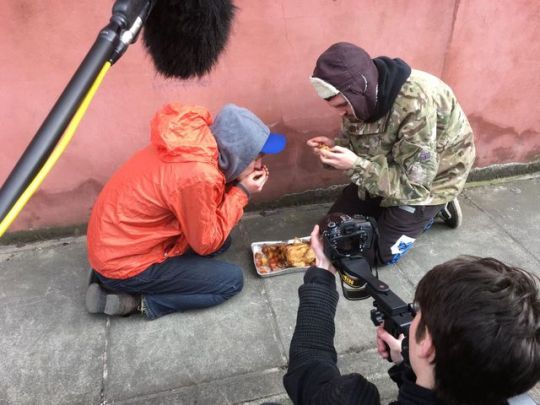
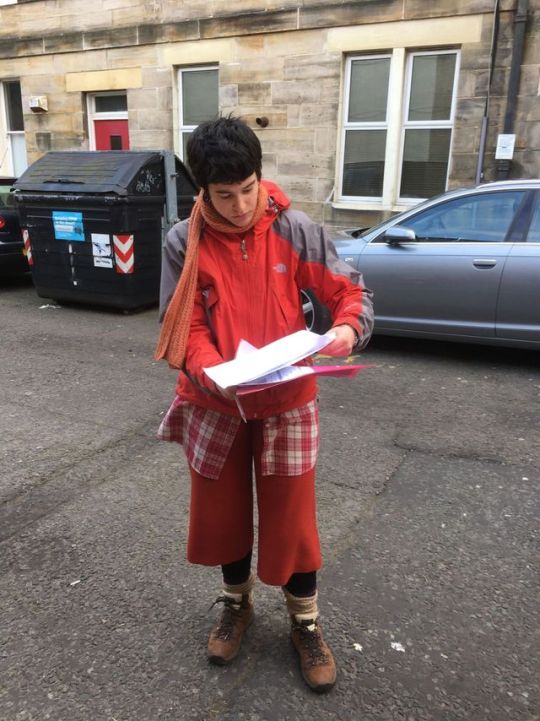
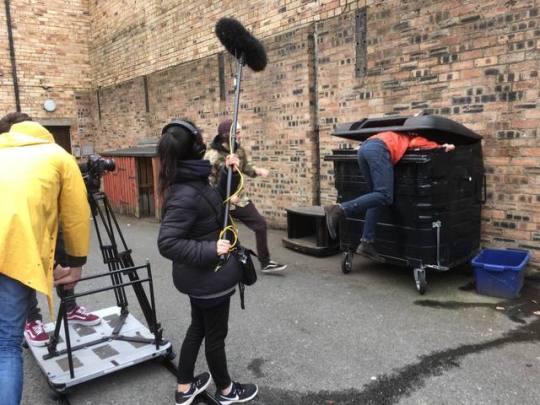
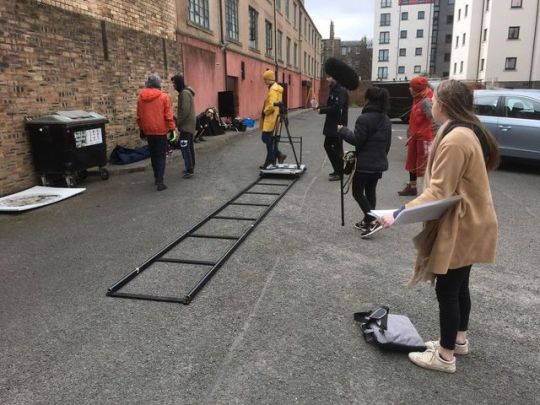
Waiting for Godot
(Chicken and the tramps)
The process of screenwriting for the adaptation of Samuel Beckett’s play has been long and exhausting. Since the beginning, Luca and me knew that it would not be an easy play to adapt; mostly because of its lack of structure and its illogical narrative (if we can talk about a narrative at all). It has been very challenging expressing the immutability of time by structuring a definite narrative and time development. We tried to be faithful to the play, however, we had to compromise: we needed some sort of narrative.
I wanted to adapt ‘Waiting for Godot’ by giving to it a more realistic and contemporary setting. The main theme would still be two men striving to find a sense in their lives; but it would also concern the physical struggle of two tramps, who are driven crazy by the cold weather and hunger pangs. Instead of the tree, I put a rubbish bin. I wanted to emphasize the brutality of the reality they live in, but I wanted to do it with humour.
Luca and me initially agreed on that, but we had slightly different visions: I wanted to focus more on the lightheartedness, slapstick and absurdism of the script; while he would have liked a script more committed politically, in order to make an harsh critique of society. We struggled a lot in creating the characters and in intertwining characters and plotline. Also it took much time to understand what the other wanted out of the script, but we finally found a balance between our two visions.
During the whole period, the characters changed a lot, and the narrative form as well went through a lot of modifications. We chose to follow a cyclic structure, which in our opinion suited best the play. We mainly took inspiration from two philosophical concepts; Nietzsche’s eternal return and Schopenhauer’s pendulum. In specific, I wanted to portray how human desires work, and what happens when a desire is accomplished - in Schopenhauer opinion, you just go back to a condition of apathy, and this is what I tried to express in the script.
It took twelve drafts to accomplish the final version: improvising with actors and with each other helped us to see what worked and what didn’t work. At a certain point Luca and me fell into this delirious state of mind in which we started embodying the characters - we thought we wouldn’t have come out of the eternal return, but we did it, and I’m proud of our result: it has been very useful experiencing the writer-director collaboration.
Aside from writing, I have also covered the role of 1st Assistant Director. I have been scheduling considering first of all the number of shots, the approximate length of the shots (taking in consideration camera movements, use of dolly, etc.), and possible light changes, since it was an outdoor shoot and we had to keep some sort of lighting continuity if possible. However, Luca preferred to follow the moving from one location to another.
We had three locations which were more or less close to each other, but we carried everything by ourselves when moving, so I had to calculate the time it took from one location to another. The hardest thing, I’d say, has been being able to have authority on set. Luca and Kelvin kept adding shots even if at a certain point we ran behind the schedule, and I had to be the one stressing everyone out and being very annoying (as a sidenote, I really appreciated bullying around).
Even though I usually prefer more creative roles, I enjoyed keeping the schedule, and I think I kept it quite well since we wrapped exactly when I planned to wrap; at 6:30pm. I also enjoyed filling in the call sheet, as weird as it may seem - I think that filling it out gave me a pleasant feeling of having everything under control and keeping track of everything that could have gone bad during the shoot.
0 notes
Photo

The Italian Way
STEP 3: EDITING
Editing the teaser has been much more different than editing the full length short film exactly because I didn’t have any script and therefore no precise development to follow. It has been more like editing a documentary; I logged all the footage first and then I tried to give a shape to the material I had by testing various combinations.
Regarding the edit of the short film, the hardest thing to tackle has been time management, since I only had two weeks for both the ficiton and the documentary edits and in those two weeks I have been traveling back home. I think it has been my fault to have taken too many responsibilities at once. After having talked to the producer about the situation, we agreed that I should have focused on the picture to the detritement of sound design, and I took more time for the edit, even if that meant delaying the whole post-production process.
To synchronize picture and sound, I tried ‘PluralEyes’ for the first time; however, this made me waste time since when importing ‘the frames got stuck’. I’m still not sure what it means, but I couldn’t even ask for help since I was not in Edinburgh. So I just proceeded with the old AutoSyncing way. This actually made me realize how much I still have to learn about the technical/scientific side of editing.
Diving into the depths of Avid Media Composer, I learnt something that I had never tried before, like applying effects such as slow motion and the split screen, which has been particularly amusing to edit. Another thing that has been challenging was the bingo scene, since I edited the flashback directly on the music that I knew I would have used (Ennio Morricone, For A Few Dollars More), trying to build a rhythmical sequence.
Overall, I tried to keep a fast and snappy pace, even though it wasn’t entirely possible because I used many camera movements and long shots in various points - something that was planned, but I’m still not sure if it worked as a general style. The whole edit alternates relatively slow long shots and short fast paced juxtapositions; however, the long shots’ pace is maintained quite fast thanks to the fast pannings.
0 notes
Photo
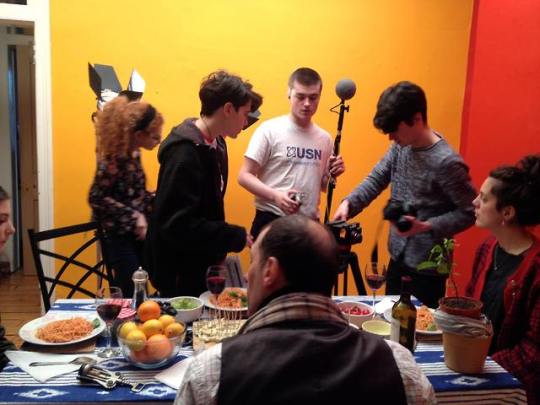
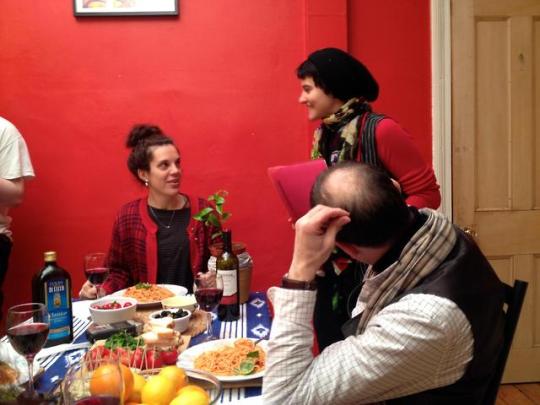

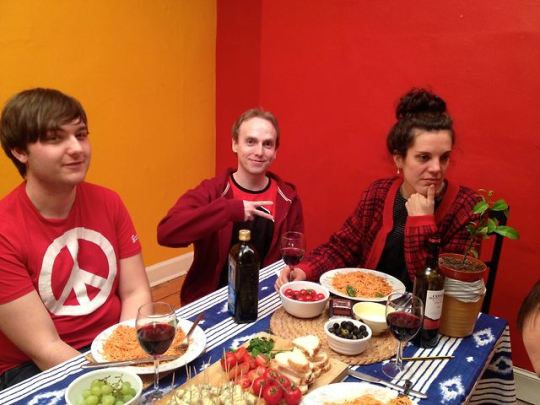
The Italian Way
STEP 2: DIRECTING
Once the script was finished, I started to translate everything visually through storyboarding. I made several storyboards in order to understand the best way to capture the whole scene. Talking about visual style, I have been much influenced by Italian Neorealism and socialist realism; also I have been inspired by Pedro Almodovar regarding the general atmosphere - I especially appreciate his lightheartedness.
The cinematographer and me have been working on separate shotlists before deciding the final one; one could say that the final shotlist was a merging of the two. We disagreed in many points, which made me think how much input the cinematographer has on the narrative; however, we agreed on the general visual style and we have always been able to overcome disagreements with sucess. My initial idea was to keep the whole situation quite random, spontaneus, almost surprising, and the cinematographer understood this very well - she enhanced the randomness and she helped me developing what in my mind was only a sketch.
To me, the way to keep everything spontaneus was through camera movements and acting. Regarding camera movements, the cinematographer and me agreed to use many pannings. The camera would follow the action as through the eyes of the audience, to give the impression of realism. At the same time, however, we also planned to ‘break’ the action by using many shots/reverse shots, to create some kind of shots’ conflict, following the traces of Sergej Eisenstein. I am not completely sure if this merging of styles worked, but it has been a very interesting experimentation.
Directing the actors has also been an experiment. We had, indeed, a cast of half actors and half non-actors. I have been reading ‘Directing Actors’ by Judith Weston extensively; however, I realized quite soon that her techniques would not have worked with people who had never been on screen/ who have never acted before. I therefore researched how to work with non-actors and I particularly found interesting Ken Loach’s advices on that. However, it was clear that the casting had to be a big part of it - we had to choose people who genuinely were the characters.
I tried to keep my directions as simple as possible when working with non-actors, trying to face them with real life situations; using much imagination and inventiveness. What I wanted to do was building a strong bond between the actors: I wanted to recreate a real family. To do that, we met for rehearsals and instead of focusing on the lines, I tried to make them feel at ease. I allowed time for them to know each other by playing some simple games. We played ‘action and reaction’, with actions which would have been useful for the purpose of the script, in order to prepare them emotionally.
The hardest thing has been managing actors and non actors together. One issue that arised during the rehearsals has been line-memorization and blocking. Non-actors worked very well when improvising but had many difficulties in remembering the lines. When focusing on the lines, their acting was stiff, unnatural. But that was not the only issue. The actors pretended that the non-actors memorized the lines and they started becoming quite contentious towards the non-actors, who consequently felt let down. The tension was quite high, and I tried to use it on set, directing the personal stress of the actors towards the characters themselves.
Even though I enjoyed directing an improvisation, we only improvised for the teaser and not for the full-length short film. In the teaser we had a plot outline, and consequently both actors and crew had to improvise. It has been hard, even though a good experience (I took inspiration from Mike Leigh). We decided to not replicate it for the film since we would have needed too much time to film and we couldn’t have planned a more detailed schedule; it would have been risky and much more undefined - that’s why it was required that the actors memorised the lines in the short film. However, these are simply two different modes of production (and consequently, two different ways of directing) which I’ve been able to experience this semester and that I’d love to explore further.
0 notes
Text
The terrifying act of writing
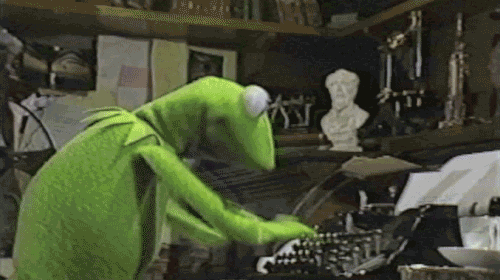
The Italian Way
STEP 1: SCREENWRITING
How to transform drama into comedy, and in specfic, how to adapt J.Priestley’s ‘An Inspector Calls’ in a comical way? This was my first question after having read the play and after having watched the television adaptation directed by Aisling Walsh. The idea that the producer (Vanesa) and me had in mind could have only been a comedy, it was clear since the beginning. However, this was not too easy to adapt, since we had to translate all the elements of the play into a completely different genre.
At the beginning, we were quite unsure on how to divide the roles. We initially started working collaboratively, brain storming and hunting for ideas, in that improbable stage when everything still has to take a consistent shape. We immediately realized that one of us had to take responsibility for the screenwriting process, since we all had different visions. My colleagues and me agreed that I would have taken the role of the writer, aside from directing.
One may think that writing and directing your own script is easier than working collaboratively. However, it has been only relatively easier, for two different reasons. I tried to consider my colleagues’ opinions and feedbacks, however, sometimes such observations were not related to screenwriting but to directing, which made me wonder when the creative process of the writer ends and the creative input of the director begins. This seems a fundamental question, which I had to face also in other collaborations.
Because I have been working on two scripts at the same time (The Italian Way and Waiting for Godot), I have experienced two very different ways of working on a script. In ‘Waiting for Godot’, I had to constantly compromise with the director - which means constant feedback. This gave me the support and the strength that I needed to make sense of that tangled ball of ideas. On the contrary, for ‘The Italian Way’, I felt completely alone with myself, swimming in an ocean of possibilities. That was terrifying.
First of all, I started asking myself which parts we could have used from the original play, which parts we could have left out. Talking to the producer has been helpful at this stage, since we both agreed on the main focus of our film and the main focus of the play. We wanted to set everything in the initial dinner scene and create a similar situation to that of the play. However, we imagined that instead of being accused of outrageous sins, the family would have been accused of silly crimes. But these silly crimes are extremely immoral, especially for italians.
My main idea since the beginning, indeed, was to portray a clash of cultures in a light-hearted way, making fun of Italians’ strict taboos on food; taboos which are often seen as ridiculous and senseless by British people. To achieve this, I tried to create contradictory characters: Sig. De Luca is nationalist and conservative; Graziella wants to lose weight; Laura is vegetarian and she’s firmly convinced of her ideas. However, Sig De Luca eats marmite, Graziella is bulimic, Laura craves meat. The through-line that I wanted to keep is that everyone struggles towards some ideas, but they have fallacies which make them ‘weak’ and more human.
In this sense Nikita, the boyfriend, and Archie, the gossipy neighbour (who replaces the menacing inspector), act like the judging eyes through which we observe the family. At the same time, Archie and Nikita are judged by the family. This judging battle isn’t entirely solved, however by the end of the script the spaghetti cutting previously considered as the most barbaric atrocity by the family, gains another meaning, because the characters have been ‘defeated’ by Archie and have aknowledged their fallacies. After several redrafts and various existential crises, I can consider myself quite satisfied of the script.
0 notes
Photo
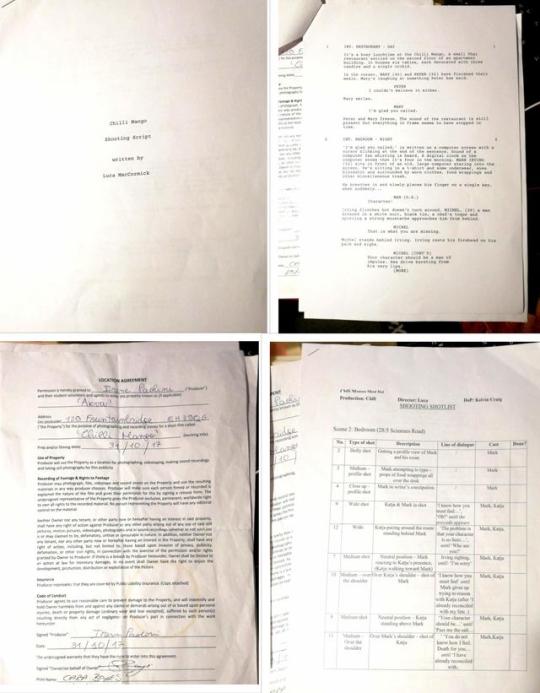
In this first trimester, I have been covering the two main roles of producer and editor in ‘Chilli Mango’, which has been renamed as ‘INT. RESTAURANT – DAY’. I have to be honest, my main interest has never been producing and neither editing. I have always wanted to write and direct– but since my script had not been chosen, I thought that it would have been helpful to experience other roles, especially editing; which is much more creative than producing in my view.
Producing hasn’t really crossed my mind, although I have had some experience as producer, until in class they asked: ‘who wants to produce Chilli Mango?’. I remember there was an embarrassing silent moment in which no one answered, and then I raised my hand, unsure of what I was doing. Everyone scrutinized me. I feel like the general reaction was – what? Irene producing?! This is going to be a real mess! -. I think I don’t have the fame of being the most organized, so my classmates were quite surprised, also because they knew that producing has never interested me that much. I blushed violently, realizing what I had just done.
However, I don’t regret my decision at all. We have been going through hard times, and I really learnt a lot. I challenged myself and I found out that my organizational skills are not that bad, after all (I mean, I’m not a disaster, at least). What brought me to produce Chilli Mango was mainly the script, which I thought was quite an original piece, and the fact that Luca was directing it: I have always liked his style, but I never got the chance to work with him before. I also think that I have a tendency to throw myself headlong into the most improbable projects – I’d say, it’s a lifestyle.
The reason why I call Chilli Mango an improbable project is because it required much effort production wise. There were various things that could have gone wrong and many things that indeed went wrong, but as I said elsewhere, I think the most important thing in film and in creative fields is flexibility. In certain moments we have been laughing of desperation. If in these moments we had not come up with a creative way of bypassing the obstacle, we would have been stuck and sunk into a quicksand. I’m talking about problem solving, which I think is the funniest part in producing. Harder it is, funnier it is.
As soon as we pitched, Luca and me started forming the crew. This was an apparently easy step. At this stage of the process everything was running a bit slow because the script was not ready. We had an early production meeting in which we also discussed the script together. The director (Luca), the first assistant director (Alex) and the director of photography (Kelvin) attended it. I had already started scheduling before that. We set up individual and common goals; and general deadlines. In my schedule, I counted approximately three weeks for pre-production and three weeks for post-production.
The ideal weeks to shoot were the last week of October and the first week of November, to leave a fair amount of time for both pre and postproduction. The first thing I did was asking everyone’s availability. It was clear that we only had two days each week in which all the crew was available, due to everyone’s commitments. At the same time, Luca and me worked together to find a location. He made me understand which type of place he was going for, and I went location scouting, documenting my findings through pictures.
We needed two locations: a bedroom and a restaurant. The bedroom would ideally be spacious in order to fit the whole crew, and silent. The restaurant, not too noisy and well lit. I thought that finding a bedroom in Edinburgh would have been the easiest thing, but that was just apparently easy. Indeed, all the bedrooms I found were either too noisy (because they were close to busy roads) or too small. I finally found a room which seemed perfect, and Luca liked it as well.
Regarding the restaurant, I proceeded mainly by sending emails to restaurants’ managers/owners and talking to them in person, leaving written letters for them to read afterwards, so they would have had my contacts if needed. At first, I was attempting to convince them to let us film in their restaurants while they were closed. However, this required them to open the location specifically for us for approximately four hours; and most of them were not willing to do that. I eventually found Akva, which I thought could have been a good compromise as it has two floors and during the weekdays no one really uses the second floor – so there would have been relatively less noise and more space for us to film. I agreed with the managers to film there the 31st of October by letting them sign the location agreement.
However, we had some trouble with the crew’s availability at this point, as Kelvin took another commitment the day we planned to film. I will not discuss here this – I think there has been a misunderstanding and I either haven’t been enough clear in communicating the dates, or Kelvin just forgot about it. The issue was that it was the only day possible for filming in that specific location I found. Indeed, the date we planned to film was Thursday 2nd November – but Kelvin couldn’t make it. The only other date in which everyone was available was Saturday 4th November. But the bedroom was not available during the weekends. This was hard to sort out.
Filming the week after was off the table, because it would have been too late (we also had a crit the Thursday after, so it wouldn’t have been possible in any case). I tried to talk both to Kelvin and to Whole’s producer, because Whole and Chilli Mango had clashing shooting dates, but they have been irremovable. I was extremely desperate at that stage, but in only one afternoon I found a location in which we could have filmed on Saturday 4th November, and all the problems were solved: the room was big and quiet, but we required the production designer to work on it because it was quite tidy and we wanted it to be chaotic.
We only started casting when locations and schedule were mostly set, since I wanted to communicate to the actors the possible dates and the locations to make everything easier. The casting has been another long and extenuating stage. I posted the casting call in different Facebook groups and I sent it through emails to acting schools; we also used Mandy. We even got applications from London. Surprisingly enough, we got more replies by actors from Glasgow. At first, Luca, Alex and me decided to ask them to send us self-taped auditions, but it didn’t really work. So we set up two dates: 17th October for auditions in Edinburgh and 24th October for auditions in Glasgow.
Alex, Luca and me went to Glasgow together twice; once for auditions and once for rehearsals. I mostly managed both and scheduled them – I was indeed the one keeping in touch with actors (even if Luca also sent emails to them when communicating our decisions). Alex, Luca and me also discussed together the performances to decide which actor suited which role. Production wise, it has been quite problematic for the fact that most of the actors we decided to cast were coming from outside Edinburgh, and we had to pay for transport as we wrote it on the call sheet.
We had several issues considering the budget. For example, one actress asked us if it was possible to come by car. We said yes because after checking on Google it seemed that it wouldn’t have been much more expensive than taking the bus. But after that, she gave us the receipt pretending us to pay for twenty pounds, which is much for a single person’s travel expenses, considering that it is a student project. I recognise it has been our fault: we should have set a percentage up to which we could have covered the costs and we should have communicated that to the actress. I think one of the main mistakes I made is that I haven’t done any budgeting during pre-production, since we had zero budget, but I am now 100% sure of the fact that any film has a budget.
Another thing that happened is that during the shooting one of the actors had lunch in the restaurant and gave us the receipt, again, pretending us to pay for it (while we had never specified that we would have covered for it). Again, I recognise it could have been my fault because, as I found out later, there must always be food on set; even if it’s a 4 hours shoot (however, it may also be true that the actor decided to take advantage of the situation). For the other date, indeed, we had plenty of food and drinks, prepared by Alex; with whom I worked closely for the risk assessment, the shooting shotlist, the schedule and the call sheets.
The shooting ran smoothly thanks to Alex, who is a very good 1st AD, and also because we tried to eliminate most of the problems during the pre-production phase. For example, Luca had almost thirty shots initially – but we worked together to take approximately ten shots out of the shotlist, because otherwise we would have had trouble with the schedule. Also, I think we have been pretty successful in managing the times in which the actors were coming and going (each of them had their own commitments, and this all made everything more difficult, but we made it).
Another issue we had during the pre production was the costumes, and in particular Avocado’s costume. We had a production designer and costumer who has been working on it since mid October, but Luca was not completely happy with it as he thought it was not much cinematic. We even thought of changing the script (which had to be revised in any case after the casting); but we didn’t do it, and I think that the theatrical style of the prop makes the performance of the Avocado even funnier.
I started editing right after we finished shooting, the Monday after. However, it took a whole week to import, synchronize and log all the footage – also because I was not that confident with Avid, at least at the beginning. I worked with Luca at first, watching all the footage with him, and then I started working on my own by creating different sequences, but I took in consideration Luca’s preferences regarding the performances. On Monday, 20th November I had a rough cut – however, there was still much to work on.
After the tutorial session I had with Catriona, I decided to follow her suggestions and I took out a whole part of the script to make it flow. I enjoyed cutting the film a lot – I felt like I had the responsibility to take out all the unnecessary, something that Luca didn’t agree with first, but he resigned when he saw that it was working better. I also enjoyed a lot intertwining the plot and the different shots to make of the film something meaningful, considering facial expressions and subtexts too.
Overall, I think we achieved our aim, as the film works and most of the people find it funny and touching. But there are several things I would like to change: the sound design and the colour correction are not the best, mainly because we spent much time working on the picture and we didn’t leave enough time for sound design and colour correction. Indeed, we kept having feedback on the picture until four days before the deadline; and we couldn’t have worked on sound and colour without having the picture locked. However, we’re going to refine both sound and colour quite soon so that we’ll be completely happy with it.
0 notes
Text
Flamenco project - sound report
This summer, when I was listening to some music, I decided I would have joined flamenco classes. It was a completely random decision and apparently unmotivated. I was extremely fascinated by the power and the energy which this dance gives off. Plus, I’ve always been interested in what one could call ‘popular culture’. Indeed, flamenco was, at least originally, the dance of the gitans - the poor people, the folk. I had danced taranta in the past, which is danced by peasants and people of humble origins. I found very interesting similarities between this and flamenco. They are full of strength; their rhythms are similar as well; but most importantly, what really links them, is the concept behind them.
Taranta is one of the most famous south Italian dances. It originated as a cure from tarantula’s bite. It was therefore a dance with healing powers. To me, flamenco has – maybe unwittingly- the same effect: it’s a collective ritual, a form of collective catharsis. However, this state of mind, which flamenco performers call ‘duende’, is not easy to reach. The duende is a spirit, which is supposed to bring the artist face to face with death. Christopher Maurer says that in duende, there are four basic elements: awareness of death, earthiness, irrationality and the diabolical. This is the point where taranta and flamenco meet.
When I heard about the sound project, I have immediately thought about flamenco. I have always thought it would have been an interesting topic to develop in general for a film or documentary. But especially for the sound project, it seemed very well suited. I thought that the sound of heels would have been very interesting to record. I didn’t have a clear narrative, and I didn’t even know if having a sort of narrative was necessary. I started talking about flamenco with some of my classmates, and as they were also interested in the project we all met to have a brain storming session. I must say, this, along with the editing, has been the hardest part of the process to me. Giving a shape to it – that is the hardest thing. We all knew, however, that we wanted to communicate the power of flamenco, and especially of duende; and that the best way of doing that would have been through poetry.
We first of all started recording flamenco classes; we went several times to make sure that we would have had enough material, because there are many different styles of flamenco. Our idea was to mix the dancing and the sound of a musician playing guitar. However, Mariam – the music expert – raised many issues that Vanesa, Via and me wouldn’t have thought about as we don’t have enough experience with musical rhythms. We thought it would have been a matter of sticking together music and dancing, but it’s not so easy as it seems. What also made things more complicated is the fact that the musician was very busy during that period of time, so we didn’t get all the material we needed. Initially, we wanted to incorporate an interview of him talking about what flamenco meant to him – but we ended up recording a poetry that Mariam wrote.
The whole process of shaping continued through editing: I am surprised now, thinking about it, how the initial purpose changed – at the beginning, we wanted indeed to portray the clash of cultures (the contrast between a flamenco school and the Scottish environment is intriguing), but we ended up with an abstract piece of work, half documentary and half poetry. Over all, I think we have all put our input and we all worked as a team through all the stages: pre production, recording, post production. I think it would be interesting to explore this topic visually as well in the future.
0 notes
Link
Kino Naples - Grande Vento 2016 How to eat props. A guideline.
‘Kino Kabaret is a type of innovative film-making lab where invited artists create films in a mindset of spontaneity and collaboration. The production method utilizes principles of non-competitive work to encourage co-creation.’
A dear friend of mine talked to me about this movement, which gathers filmmakers and allows to create crews, film shorts and screen them in a period which goes from three days to two weeks. It’s organized in many cities all over the world, especially Europe, USA and Canada, where the movement started. This intrigued me so far that I decided to go, and a week after I was in Naples (in which I fell in love - I’m planning to go back to film he surroundings soon).
I only had a script about a flying baba’, written until 4 am before the flight, after a long talk on Skype with my faithful colleague and actress. We had the most ridiculous ideas (more the time passes, more I am convinced that such hours at night are the best for ideas). For you to know, babas are delicious sweets filled with rum, which are famous in Naples. The script was basically an excuse to eat as many props as possible.
But when I arrived in Naples and I met my collegue, we had to re-invent everything. We had no microphone, no camera, no actors, only a computer without a good editing program - which is quite useless. Out of necessity, we decided to make a silent movie, and we drew a last minute storyboard. The main idea was still there, but the baba’ turned from alien on a spaceship into a persecutor, a monster. Instead of making a sci-fi comedy, we decided to make an horror comedy. A baba’ can be so many things if you wish!
Meeting wonderful people such as Stefano, Zoe, Dario and Salvatore, who believed in this crazy project, allowed us to produce this short-film. I must add that it was the first time for Stefano in front of a camera, and the first time for Zoe as d.o.p. - they have been amazing. We enjoyed working together (and eating together props). It has definitely been a great experience.
I am already thinking of organizing a kino kabaret in Edinburgh, because Edinburgh has much to offer filmmakers. In my opinion, kino-kabarets go straight to the essence of cinema. Being flexible, adapting yourself to the circumstances: it is essential. Collaborating - because filmaking is teamwork. And low budgets are not a limit, but a creative tool.
0 notes